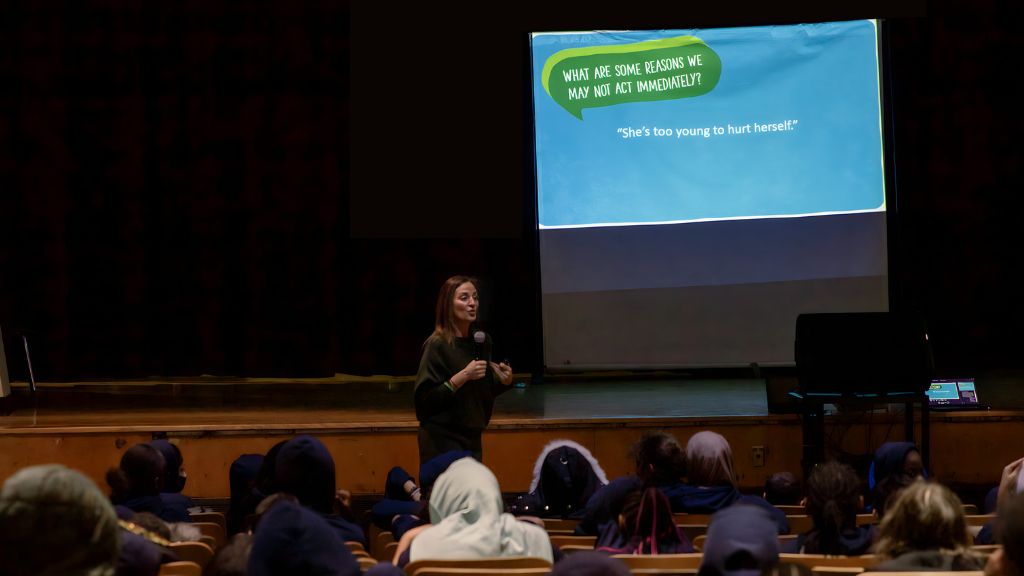What Is the STOP Act?
Sandy Hook Promise helped write and pass this bipartisan school safety legislation — the first of its kind — to prevent violence in schools. Its goal is to build upon the research and lessons learned from Sandy Hook and other tragic shootings and expand access to proven school violence prevention programs to all students nationwide.
The STOP School Violence Act was introduced on January 30, 2018. It passed in the House with almost unanimous support on March 14, 2018, and was signed into law on March 28, 2018.

Why Is It Important?
When students and educators are trained to identify signs of violence or shootings — such as through Sandy Hook Promise’s Know the Signs programs — they can prevent tragedies and save lives. Four out of five school shooters tell someone about their plans ahead of time. Unfortunately, many youth and adults who observe these signs do not recognize or report what they are seeing. The STOP School Violence Act helps more schools access these life-saving programs and create more Upstanders in prevention, rather than bystanders to violence.

What Does the STOP Act Do?
The STOP School Violence Act makes annual grants available to states, school districts, and tribal organizations to bring evidence-informed programs and strategies to schools. Through these programs, students, school personnel, and local law enforcement are trained on how to recognize signs of violence or a mental health crisis, and learn how to safely intervene to prevent people from hurting themselves or others.
The legislation also encourages the development and operation of anonymous reporting systems and the formation of school-based threat assessment and intervention teams to help intake and triage threats before tragedy strikes.
How Will This Affect Teachers and Core Curriculum?
The STOP School Violence Act gives all educators and administrators access to critical funding to bring violence prevention programming to their schools at no cost. STOP is not a mandate and provides flexibility for states, districts, and tribes to choose the evidence-based programs that best fit the needs of their students and communities. Sandy Hook Promise’s Know the Signs programs meet the STOP Act requirements. States and school districts may also choose programs that, like Know the Signs, can be delivered through digital, in-person, classroom, or large assembly training — offering even more options to fit with their current curriculum.
Do These Types of Measures Work?
Yes! To date, Sandy Hook Promise has trained more than 21 million youth and adults in 26,000+ schools in signature Know the Signs programs that focus on prevention to help end school shootings and youth violence. Through these no-cost programs, Sandy Hook Promise has averted multiple school shooting plots, teen suicides, and countless other acts of violence.
How Can I Apply for STOP Grant Funding?
If you’re interested in getting STOP funding for your school district or community, please do the following:
Go to the Bureau of Justice Assistance website to learn how to apply for STOP grant funding. Applications open around March and usually run through June for grants to provide students and teachers with the tools they need to recognize, respond quickly to, and help prevent acts of violence.
You can also subscribe to alerts from Grants.gov to stay updated on changes or openings in applications.
Related Issues
Model Legislation
Research has proven that we can prevent school violence, shootings, and other harmful acts when we teach youth and adults how to identify at-risk behaviors and intervene to get help. We work to expand access to evidence-based training for all students.
Vossekuil, B.; Fein, R.; Reddy, M.; Borum, R.; & Modzelski, W. The Final Report and Findings of the Safe School Initiative: Implications for the Prevention of School Attacks in the United States. U.S. Department of Education, Office of Elementary and Secondary Education, Safe and Drug-Free Schools Programs and U.S. Secret Services, National Threat Assessment Center, Washington, D.C., 2004.
